Government Monarchy the title Tuʻi Tonga was abolished 1865 Date dissolved 1865 | 950 CE 'Aho'eitu 'Aho'eitu brought his faction to Samoa 950s | |
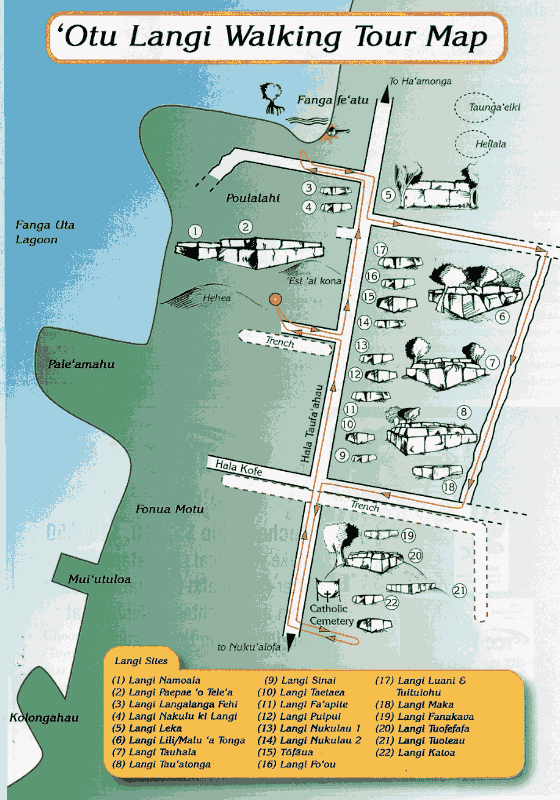 | ||
Tu i tonga empire
The Tuʻi Tonga Empire or Tongan Empire in Oceania are descriptions sometimes given to Tongan expansionism and projected hegemony which began around 950 CE, reaching its peak during the period 1200–1500.
Contents
- Tu i tonga empire
- Beginning of Tongan expansionism
- Expansion 12001500
- Decline of Tui Tonga and Two New Dynasties
- Modern scholarship
- References
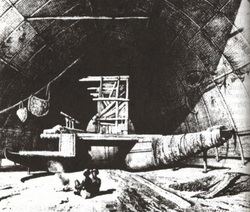
It was centered in Tonga on the island of Tongatapu with its capital at Muʻa. While modern researchers and cultural experts attest to widespread Tongan influence and evidence of transoceanic trade and exchange of material and non-material cultural artifacts, empirical evidence of a true political empire ruled for any length of time by successive rulers is lacking.
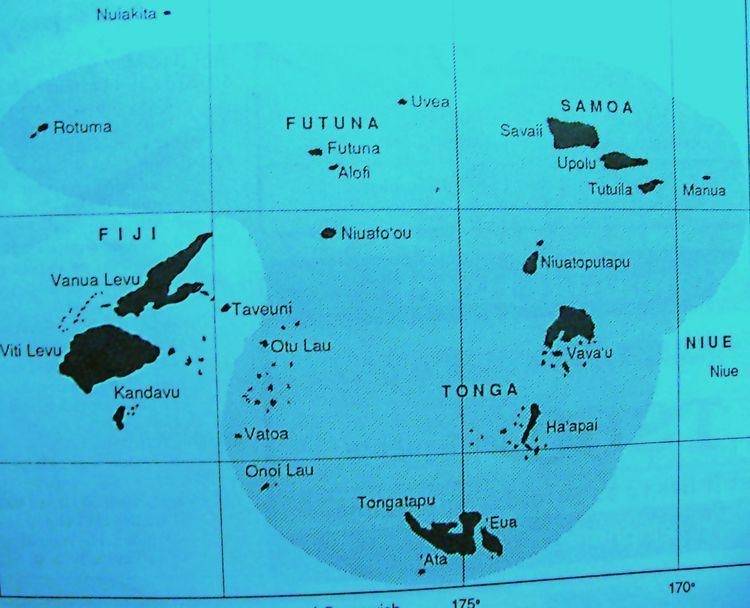
Beginning of Tongan expansionism
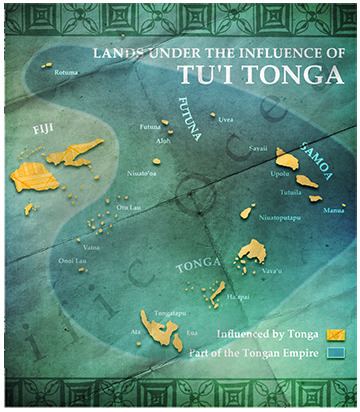
In 950 AD Tu'i Tonga 'Aho'eitu started to expand his rule outside of Tonga. According to leading Tongan scholars, including Okusitino Mahina, the Tongan and Samoan oral traditions indicate that the first Tu'i Tonga was the son of their god Tangaloa. As the ancestral homeland of the Tu'i Tonga dynasty and the abode of deities such as Tagaloa 'Eitumatupu'a, Tonga Fusifonua, and Tavatavaimanuka, the Manu'a islands of Samoa were considered sacred by the early Tongan kings. By the time it comes to the 10th Tu’i Tonga Momo, and his successor, ‘Tu’itatui, the empire had already stretched from Tikopia in the west to Niue in the east. Their realm contained Wallis and Futuna, Tokelau, Tuvalu, Rotuma, Nauru, parts of Fiji, Marquesas, parts of the Solomon Islands, Kiribati, Niue, Cook Islands, and parts of Samoa. To better govern the large territory, the Tu’i Tongas had their throne moved by the lagoon at Lapaha, Tongatapu. The influence of the Tu’i Tonga was renowned throughout the Pacific, and many of the neighboring islands participated in the widespread trade of resources and new ideas.
Expansion (1200–1500)
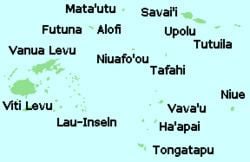
Under the 10th Tuʻi Tonga, Momo and his son Tuʻitātui (11th Tuʻi Tonga) the empire was at its height of expansion, tributes for the Tu'i Tonga were said to be exacted from all tributary chiefdoms of the empire. This tribute was known as the " 'Inasi " and was conducted annually at Mu'a following the harvest season when all countries that were subject to the Tu'i Tonga must bring a gift for the gods, who was recognized as the Tu'i Tonga. Captain Cook witness an Inasi ceremony in 1777, in which he noticed a lot of foreigners in Tonga, especially the darker people that resembles African descend from Fiji, Solomon Islands and Vanuatu. The finest mats of Samoa ('ie toga) are incorrectly translated as "Tongan mats;" the correct meaning is "treasured cloth" ("ie" = cloth, "toga" = female goods, in opposition to "oloa" = male goods). Many fine mats came into the possession of the Tongan royal families through chiefly marriages with Samoan noblewomen, such as Tohu'ia the mother of Tu'i Kanokupolu Ngata who came from Safata, 'Upolu, Samoa. These mats, including the Maneafaingaa and Tasiaeafe, are considered the crown jewels of the current Tupou line (which is derived matrilineally from Samoa). The success of the Empire was largely based upon the Imperial Navy. The most common vessels were long-distance double-canoes fitted with triangular sails. The largest canoes of the Tongan kalia type could carry up to 100 men. The most notable of these were the Tongafuesia, ʻĀkiheuho, the Lomipeau, and the Takaʻipōmana. It should be mentioned that the Takaʻipōmana was actually a Samoan kalia; according to Queen Salote and the Palace Records this was the Samoan double-canoe that brought Tohu'ia Limapō from Samoa to wed the Tu'i Ha'atakalaua. The large navy allowed for Tonga to become wealthy with large amounts of trade and tribute flowing into the Royal Treasury.
Decline of Tuʻi Tonga and Two New Dynasties

The Tuʻi Tonga decline began due to numerous wars and internal pressure. In the 13th or 14th century Sāmoa defeated Tu'i Tonga Talakaifaiki under the lead of the Malietoa family. In response the falefā was created as political advisors to the Empire. The falefā officials were initially successful in maintaining some hegemony over other subjected islands but increased dissatisfaction led to the assassination of several rulers in succession. The most notable were, Havea I (19th TT), Havea II (22nd TT), and Takalaua (23rd TT), who were all known for their tyrannical rule. In AD 1535, Takalaua was assassinated by two foreigners while swimming in the lagoon of Mu'a. His successor, Kauʻulufonua I pursued the killers all the way to ʻUvea, where he killed them.
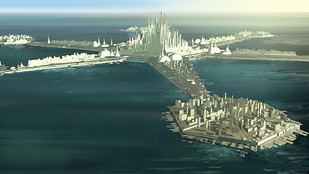
Because of so many assassination attempts on the Tu'i Tonga, Kauʻulufonua established a new dynasty called Tu'i Ha'atakalaua in honor of his father and he gave his brother Mo’ungamotu’a, the title of Tu’i Ha’a Takalaua. This new dynasty was to deal with the everyday decisions of the empire, while the position of Tu’i Tonga was to be the nation’s spiritual leader, though he still controlled the final say in the life or death of his people. The Tu'i Tonga "empire" at this period becomes Samoan in orientation as the Tu'i Tonga kings themselves became ethnic Samoans who married Samoan women and resided in Samoa. Kau'ulufonua's mother was a Samoan from Manu'a, Tu'i Tonga Kau'ulufonua II and Tu'i Tonga Puipuifatu had Samoan mothers and as they married Samoan women the succeeding Tu'i Tongas - Vakafuhu, Tapu'osi, and 'Uluakimata - were allegedly more "Samoan" than "Tongan."
In 1610, the 6th Tu’i Ha’a Takalaua, Mo'ungatonga, created the position of Tu’i Kanokupolu for his half-Samoan son, Ngata, which divided regional rule between them, though as time went on the Tu’i Kanokupolu’s power became more and more dominant over Tonga. The Tu'i Kanokupolu dynasty oversaw the importation and institution of many Samoan policies and titles and according to Tongan scholars this Samoanized form of government and custom continues today in the modern Kingdom of Tonga Things continued this way for a long time afterward. The first Europeans arrived in 1616, when the Dutch explorers Willem Schouten and Jacob Le Maire spotted Tongans in a canoe off the coast of Niuatoputapu, and the famous Abel Tasman followed soon after. These visits were brief, however, and did not change the island much at all.
The dividing line between the two moieties was the old coastal road named Hala Fonua moa (dry land road). Still today the chiefs who derive their authority from the Tuʻi Tonga are named the Kau hala ʻuta (inland road people) while those from the Tuʻi Kanokupolu are known as the Kau hala lalo (low road people). Concerning the Tuʻi Haʻatakalaua supporters: when this division arose, in the 15th century, they were of course the Kauhalalalo. But when the Tuʻi Kanokupolu had overtaken them they shifted their allegiance to the Kauhalaʻuta.
Modern scholarship
Modern archeology, anthropology and linguistic studies confirm widespread Tongan cultural influence ranging widely through East 'Uvea, Rotuma, Futuna, Samoa and Niue, parts of Micronesia (Kiribati, Pohnpei), Vanuatu, and New Caledonia and the Loyalty Islands, and while some academics prefer the term "maritime chiefdom", others argue that, while very different from examples elsewhere, "..."empire" is probably the most convenient term."
